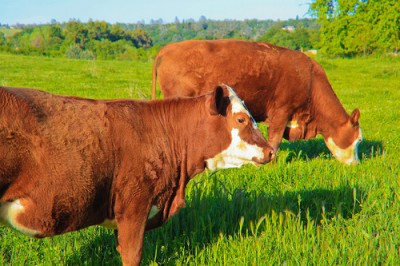I think somewhere is sweet green grass /bm e
and fresh air I smell in my dreams /bm f#m7
though I have only known this stinking lot /bm e
at this glooomy animal factory /bm f#m7
even if I am a daft little cow /em7 d
I really wanna romp and play /c bm
hang loooose with friends and butterflys /e bm
and roll around in a pretty place /f#m7 g
mooos .weet .mooog .reen .mooog rass
/em7 f#m7 g f# bm
[Go Vegan Please]
there must somewhere be sweet green grass /bm e
and dazzling trees I see in my dreams /bm f#m7
still I have only known these metal bars /bm e
at this fuuumy animal factory /bm f#m7
even if I am a dumb whiffy cow /em7 d
I’d like to roam and play /c bm
harmooo with a friend under starry sky /e bm
even smoooch in a pretty place /f#m7 g
mooos weet, mooog reen, mooog rass
[Go Vegan Please]
take me away to the sweet green grass /bm e
and little flowers I smell in my dreams /bm f#m7
yet I have only known dry corn, soybeans /bm e
at this dooomy animal factory /bm f#m7
even if I am a potty fat cow /em7 d
I’d love to dawdle and play /c bm
chew cud with friends under cobalt skys /e bm
raise a little cow in a pretty place /f#m7 g
mooos weet, mooog reen, mooog rass
[Go Vegan Please]
Sweet Green Grass / stele ely & michelle pitcher c12
SweetGreenGrass.mp3
Sponsor this Sweet Green Grass demo song with $1 – or more – so we can fine tune and record it so it will sound really nice. Then we’ll get it out there even more so it can help the people and the critters. Own part of the copyright and get your name on the by line. More info below.
What is a CAFO? A CAFO, or Concentrated Animal Feeding Operation, is an industrial-sized livestock operation.
Excerpt from Michigan.Sierraclub.org
The quantity of urine and feces from even the smallest CAFO is equivalent to the urine and feces produced by 16,000 humans.
A CAFO can house anywhere from hundreds to millions of animals.
The animals in CAFOs are most often dairy cows, hogs, or chickens.
CAFO animals are confined at least 45 days or more per year in an area without vegetation.
CAFOs include open feedlots, as well as massive, windowless buildings where livestock are confined in boxes or stalls.
Other terms used to describe a CAFO: mega farm, animal factory, hog motels, poop factories, industrial farms.
What pollutants do CAFOs produce?
CAFOs produce huge amounts of animal sewage and other pollutants.
CAFO owners and operators spend millions of dollars on technologies that make it possible to produce massive quantities of milk, eggs, and meat, yet they resist investing in technologies and practices to properly treat the wastes that are by-products of this industry:
CAFO waste is usually not treated to reduce disease-causing pathogens, nor to remove chemicals, pharmaceuticals, heavy metals, or other pollutants.
Over 168 gases are emitted from CAFO waste, including hazardous chemicals such as ammonia, hydrogen sulfide, and methane.
Airborne particulate matter is found near CAFOs and can carry disease-causing bacteria, fungus, or other pathogens.
Animals frequently die in CAFOs. Their carcasses, often in large numbers, must be dealt with.
Infestations of flies, rats, and other vermin are commonplace around CAFOs and therefore around CAFO neighbors.
Often you’ll hear owners of CAFOs argue that the wastes produced by the livestock provide nutrients that help them offset the use of synthetic fertilizers. The sheer amount of wastes produced, however, often overwhelms the ability of the land and crops to absorb CAFO wastes.
Are CAFOs sustainable? No.
CAFOs are resource-intensive and unsustainable.
CAFOs use large amounts of electricity for lighting, equipment, milkers, pumps, and irrigators.
CAFOs use fuel in tremendous quantities to run tractors, gas motors, and pumps, and to transport milk, waste, supplies, and chemicals.
CAFOs use millions of gallons of clean fresh every day to dilute waste and to wash manure from milking parlors and CAFO barns.
Excerpt from Michigan.Sierraclub.org
PETA.org
Over the last two decades, small- and medium-scale livestock farms have given way to factory farms that confine thousands of cows, hogs and chickens in tightly packed facilities. The growth of these factory farms has contributed to a host of environmental, public health, economic, food safety and animal welfare problems. Tens of thousands of animals can generate millions of tons of manure annually, which pollutes water and air and can have health repercussions on neighbors and nearby communities. Consumers in distant markets also feel the impacts, either through foodborne illness outbreaks or other public health risks.
Pollution from Giant Livestock Farms Threatens Public Health by NRDC
Factory farms — giant livestock farms also known as feedlots that house thousands of cows, chickens or pigs — produce staggering amounts of animal wastes. The way these wastes are stored and used has profound effects on human health and the environment.
On most factory farms, animals are crowded into relatively small areas; their manure and urine are funneled into massive waste lagoons. These cesspools often break, leak or overflow, sending dangerous microbes, nitrate pollution and drug-resistant bacteria into water supplies. Factory-farm lagoons also emit toxic gases such as ammonia, hydrogen sulfide and methane. What’s more, the farms often spray the manure onto land, ostensibly as fertilizer — these “sprayfields” bring still more of these harmful substances into our air and water.
Vegan Outreach .org
Factory Farms “U.S. society is extremely naive about the nature of agricultural production. “[I]f the public knew more about the way in which agricultural animal production infringes on animal welfare, the outcry would be louder.” Bernard E. Rollin, PhD Farm Animal Welfare Iowa State U. Press, 2003 Many people believe that animals raised for food must be treated well because sick or dead animals would be of no use to agribusiness. This is not true. The competition to produce inexpensive meat, eggs, and dairy products has led animal agribusiness to treat animals as objects and commodities. The worldwide trend is to replace small family farms with “factory farms” – large warehouses where animals are confined in crowded cages or pens or in restrictive 1 According to Professor Bernard E. Rollin: “[I]ndividual animals may ‘produce,’ for example, gain weight, in part because they are immobile, yet suffer because of the inability to move.”2 In the case of battery-cage egg production, Rollin explains that “though each hen is less productive when crowded, the operation as a whole makes more money with a high stocking density: chickens are cheap, cages are expensive.
[Go Vegan Please]
Musicians :: Record this song and we’ll add it here, and maybe on our home page or environmental songs page.
Artists :: Do a video, art, dance or media for this song and we’ll add it here, and maybe on our home page or environmental songs page.
Fans :: Donate $1 or more to sponsor a better version or recording of this song. Donate $44 or more to get a shared copyright certificate for this song or your choice of one of our other environmental songs.


![CAFO_Oct2006JKlein_sm[1]](https://xoearth.org/wp-content/uploads/2012/02/CAFO_Oct2006JKlein_sm1.jpg)
Leave a Reply
You must be logged in to post a comment.